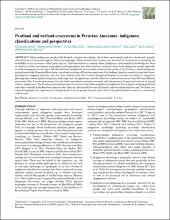Por favor, use este identificador para citar o enlazar este ítem:
https://hdl.handle.net/20.500.12921/387| Título : | Peatland and wetland ecosystems in Peruvian Amazonia: indigenous classifications and perspectives |
| Autor : | Schulz, Christopher Martín Brañas, Manuel Núñez Pérez, Cecilia Del Águila Villacorta, Margarita Laurie, Nina Lawson, Ian T. Roucoux, Katherine H. |
| Palabras clave : | Pueblos indígenas Conocimiento indígena Conocimiento ecológico Clasificación de ecosistemas Chambira, río Urarina, pueblo indígena Clasificación de suelos Turberas |
| Fecha de publicación : | jun-2019 |
| Editorial : | Resilience Alliance |
| Citación : | Schulz, C., Brañas, M. M., Pérez, C. N., Del Aguila Villacorta, M., Laurie, N., Lawson, I. T., & Roucoux, K. H. (2019). Peatland and wetland ecosystems in Peruvian Amazonia. Ecology and Society, 24(2). |
| Resumen : | Many indigenous people hold detailed ecological knowledge about their environment and have developed complex classifications of ecosystem types in their own languages. These classification systems may be based on characteristics including the availability of key resources, salient plant species, and cultural factors, among others. Indigenous environmental knowledge has been of interest to (ethno-)ecologists, geographers, anthropologists, and other scientists looking to learn from indigenous people, especially in newly emerging research topics. We identified and interpreted an ecosystem classification system of the Urarina, a small indigenous nation based in the Chambira River basin, a peatland-rich area of Peruvian Amazonia. Our findings, based on semistructured interviews, participatory mapping exercises, and site visits, indicate that the Urarina distinguish between ecosystems according to vegetation physiognomy, certain (palm) tree species, hydrology, and soil appearance, and that their use of natural resources varies between different ecosystems. Two Urarina ecosystems, jiiri and alaka, are almost certainly associated with the presence of peat soils and are of special cultural significance. The Urarina ecosystem classification system thus offers insights and inspiration for ecologists studying peatlands and other wetlands in the Peruvian Amazon who, thus far, have mostly focused on floristic and structural analyses only. Not least, our research highlights the importance of the peatlands for local people, beyond their role for the global climate system as a substantial carbon store. |
| URI : | https://doi.org/10.5751/ES-10886-240212 |
| ISSN : | 1708-3087 |
| Aparece en las colecciones: | Artículos en revistas indexadas |
Ficheros en este ítem:
| Fichero | Descripción | Tamaño | Formato | |
|---|---|---|---|---|
| Martin_articulo_2019.pdf | 7,22 MB | Adobe PDF |  Visualizar/Abrir |
Compartir :
Este ítem está sujeto a una licencia Creative Commons Licencia Creative Commons




